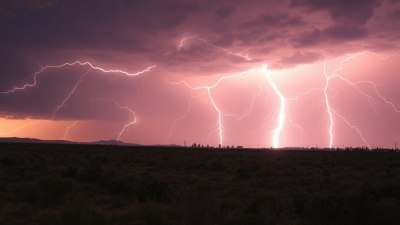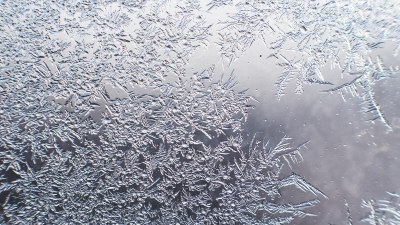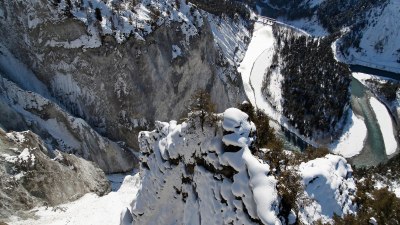Why Some Places Experience 'Dry Lightning'
Explore the causes and conditions behind dry lightning and why it occurs in certain regions more frequently.

Image created with Flux Schnell
Dry lightning is a fascinating and potentially dangerous meteorological phenomenon that occurs when lightning strikes a dry area, often sparking wildfires. Unlike typical thunderstorms that bring both lightning and rain, dry lightning produces lightning without significant precipitation reaching the ground. This type of lightning is especially prevalent in certain regions due to unique atmospheric conditions and environmental factors.
The term 'dry lightning' refers to thunderstorm lightning that occurs with little or no rainfall at the surface. The phenomenon can be deceptive because the clouds may produce rain high in the atmosphere, but the rain evaporates before it reaches the ground, a process known as virga. This evaporated rain leaves the ground dry and vulnerable to ignition from lightning strikes, creating wildfire risks.
Atmospheric Conditions Leading to Dry Lightning
The occurrence of dry lightning is heavily dependent on the vertical profile of the atmosphere, especially the temperature and humidity conditions from cloud base to the surface. During dry lightning events, storms often develop in hot, dry air masses where low humidity at the surface or in the lower atmosphere causes raindrops to evaporate before they reach the ground.
Virga is a key component in dry lightning. When rain falls from thunderclouds through a drier layer below, the droplets evaporate, cooling the air as they do so. This cooling can increase downdrafts and influence storm dynamics, but crucially, it prevents moisture from reaching the surface to dampen potential fire-starting sparks from lightning.
The height of the freezing level in the atmosphere plays a role because lightning forms primarily in mixed phase regions within clouds, where ice crystals and supercooled water coexist. However, the interaction between the storm's precipitation processes and the dry air beneath causes the dry lightning phenomenon.
Regions Prone to Dry Lightning
Not all geographic areas experience dry lightning with the same frequency. Some places, particularly those with certain climate characteristics and topography, are more prone to this weather phenomenon.
In the United States, dry lightning is common in the southwestern states such as Arizona, New Mexico, and parts of California. These areas often have hot, dry summers with limited humidity near the surface but sufficient upper-level moisture to support thunderstorms. The North American Monsoon season contributes to this pattern by bringing moisture aloft but not enough to saturate surface air, leading to thunderstorms that produce lightning without substantial rainfall reaching the ground.
Similarly, parts of Australia, particularly the interior arid zones, experience dry lightning events during hot seasons. The combination of intense solar heating, dry conditions, and occasional upper-atmosphere moisture leads to the formation of thunderstorms with virga and dry lightning.
Mountainous regions can also be prone to dry lightning. Higher elevations often have clouds and thunderstorms that form above the lower, dry layers. This vertical stratification supports conditions where precipitation evaporates before reaching the ground.
The Role of Climate and Seasonal Patterns
Seasonal and climate factors influence the frequency and timing of dry lightning events. Hot, dry conditions in summer increase surface evaporation rates and reduce humidity, setting the stage for lightning without rain.
During wildfire seasons, the risk associated with dry lightning increases dramatically because lightning can ignite fires that spread rapidly in parched vegetation. In many western U.S. regions, the summer and early fall months represent the peak dry lightning season, correlating with drought and heat waves.
Conversely, wet seasons or monsoon periods might bring more moisture to the surface, reducing the occurrence of dry lightning because rain often reaches the ground to suppress fire ignition despite lightning activity.
The Science of Lightning Formation in Dry Conditions
Lightning originates within thunderstorms through complex electrification processes involving collisions between ice particles, graupel, and supercooled water droplets in the cloud. Charges separate within the storm, typically creating negative charges near the middle or lower cloud layers and positive charges near the upper parts and the ground.
When the electrical potential difference becomes sufficient, a lightning discharge occurs to neutralize the charge disparities. This discharge can happen within clouds, between clouds, or between clouds and the ground.
In dry lighting scenarios, when lightning strikes the ground or vegetation, the absence of rain means there is no immediate moisture to quench sparks. This unquenched lightning is far more likely to ignite dry grasses, shrubs, or forest litter, setting off wildfires.
Environmental and Ecological Impacts of Dry Lightning
Dry lightning serves as a natural ignition source that has shaped ecosystems for millennia. Many ecosystems, particularly certain forest types and grasslands, have evolved with fire as a natural disturbance cycle. Lightning-caused fires can help maintain biodiversity, recycle nutrients, and clear old vegetation to make way for new growth.
However, in modern times, human developments near fire-prone areas elevate the risk and consequences of fires sparked by dry lightning. Wildfires fueled by dry lightning can threaten homes, infrastructure, and human health while causing extensive economic damage.
Climate change is expected to increase the frequency and severity of droughts and heatwaves in many regions, potentially increasing the occurrence and fire risk associated with dry lightning. This interaction poses a challenge for fire management and environmental conservation efforts.
Predicting and Monitoring Dry Lightning Events
Meteorologists use a combination of weather observations, satellite imagery, and atmospheric soundings to predict the likelihood of dry lightning. Identifying dry lightning risk zones involves analyzing moisture profiles, instability, temperature, and wind patterns to assess storm development and virga potential.
Modern satellite systems equipped with lightning mappers provide real-time data on lightning strikes across the globe. This technology, combined with wildfire detection sensors and weather models, helps emergency responders assess risk and prioritize firefighting resources effectively.
Early warning systems and public education campaigns are critical tools in minimizing fires started by dry lightning, especially in vulnerable regions during peak fire seasons.
Mitigation Strategies for Dry Lightning Fire Risks
To reduce the destructive impact of fires started by dry lightning, agencies often implement several strategies. These include controlled burns to reduce flammable vegetation, firebreak construction, community preparedness programs, and rapid response firefighting techniques.
Monitoring dryness and fuel availability helps fire managers to anticipate periods of heightened risk and mobilize resources preemptively. Additionally, land use planning that takes into account fire risks associated with dry lightning can make communities more resilient.
Educational outreach encourages residents in fire-prone areas to adopt fire-safe landscaping, create defensible space around properties, and develop evacuation plans in the event of wildfires triggered by dry lightning.
Historical Examples of Dry Lightning Caused Fires
Several notable wildfire events have been attributed to dry lightning. The 2018 Camp Fire in California, one of the deadliest and most destructive wildfires in the state's history, was sparked during dry conditions with little rainfall accompanying lightning strikes.
Similarly, the 2020 wildfires across the western United States were heavily influenced by dry lightning events during extremely dry and hot weather. These fires collectively burned millions of acres and caused massive evacuations.
Historically, indigenous peoples in some regions understood the ecological role of lightning-caused fires and used controlled burns to manage landscapes and reduce fuel loads, demonstrating an awareness of the significance of dry lightning in their environment.
Scientific Research and Future Outlook
New research continues to deepen understanding of dry lightning, including improving models that predict lightning activity in dry conditions and investigating how climate change influences these phenomena. Studies focus on cloud microphysics, lightning energetics, and interactions between atmospheric profiles and surface conditions.
Advancements in remote sensing and computational modeling help scientists analyze large datasets from satellite observations and ground networks to refine forecasting capabilities specifically for dry lightning and associated fire risks.
Looking forward, integrating this scientific knowledge with practical fire management and community planning is key to reducing the hazards posed by dry lightning while preserving its natural ecological functions.
In summary, dry lightning is a distinct meteorological event where lightning occurs without significant rain at the surface, primarily due to atmospheric conditions that cause precipitation to evaporate before reaching the ground. It is prevalent in hot, arid to semi-arid regions and during specific seasons with dry lower atmosphere conditions. While natural and ecologically important, dry lightning poses serious wildfire risks accentuated under changing climate patterns, underscoring the need for ongoing research, monitoring, and management strategies.











